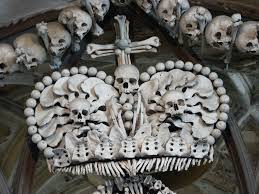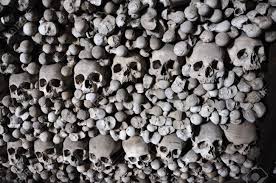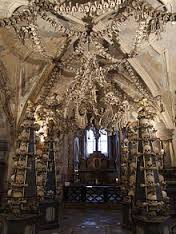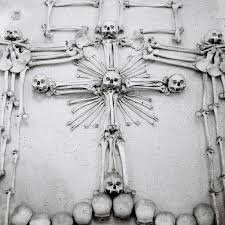“It is quite impossible for a thinking being to imagine nonbeing, a cessation of thought and life. In this sense everyone carries the proof of his own immortality within himself.”
Johann Wolfgang von Goethe
A few years ago I visited the Czech Republic and I was thrilled to explore the places where my ancestors lived. The Sedlec Ossuary is a remarkable Christian burial place not far from where my grandfather’s family originated. The Sedlec monastery and the nearby beautiful historical town of Kutná Hora, which are only a short train-ride from Prague, were high on my list of places to see and experience.
Unfortunately, in our post-Christian society this famous burial place is often depicted as an odd or even monstrous place. I was prompted to write this historical sketch due to an offensive remark in one of such article I came across, “7 of the Freakiest Places on the Planet”, a tour guide which mentions the ossuary in a list of other bizarre and freakish pagan places. I found the following statement especially offensive — “It’s difficult not to let your imagination run wild when pondering the sort of sick mind that conceived of things like a chandelier of human bones.” [1]

One can question whether it is a good thing to let one’s imagination run wild under any circumstances, especially when it turns out that the author who recommends these freaky places certainly does not understand the rich history of Bohemia, or the Medieval mindset of Christians who were buried at Sedlec. The phrase “sick mind” is an insult to those who built the ossuary, and although tempting, I will restrict myself from commenting further on the sick state of mind of the modern man who is capable of writing such ignorant drivel. But, in conclusion, I will reflect upon the modern understanding of death, and I will point out how futile are the hopes of modern atheists who wish to defeat death through science and sci-fi fantasy.
Shrouded by legends the early history of Bohemia is not well known today. The Czech nation grew out of the destruction of Great Moravia which was strongly influenced by Byzantium and Eastern Orthodoxy. However, the subsequent cultural influences were predominantly French (Franks) and German (Eastern Franks). [2] The educated and well-travelled Olomouc bishop Jindřich Zdík became a friend of St. Bernard, the abbot of Clairvaux, and it was bishop Zdík’s idea to invite the Cistercians to Bohemia. The White monks, whose motto was “Ora et labora!” or “Modli se a pracuj!”, came to Sedlec in 1142, and the monastery they built there became one of the earliest places of prayer, culture, and education in Bohemia. Their first church, built before the end of the 12th century, later grew into the impressive cathedral of the “Assumption of Virgin Mary and John the Baptist”, which is today a UNESCO site. One of the oldest documents in the monastery library was the book of antiphons called “Three Marys at the Grave of Jesus” whose authors and illustrators were well acquainted with Byzantine art and with the significance of Christian burial.
The discovery in 1260 of silver and copper ore in the mountain near the monastery resulted in a ‘silver rush’ long before that in the Klondike. Not unlike its famous American counterpart, Kutná Hora with its various ad-hoc establishments quickly turned into a town of vice where an ‘easy come easy go’ attitude of hard work and cheap fun prevailed. After it received royal privileges as the mining and metallurgical town where the Bohemian kings located their Royal Bohemian Mint, Kutná Hora, (whose name means the Metal-forging Mountain), became the second-most important town after Prague, gradually transforming its image in part by building churches instead of houses of ill-repute. The Bohemian kings were anxious to keep a close eye on the production of the Pražšký groš (Prague groschen) which, with its high silver content, became the most popular currency in Europe until it was replaced by another popular Bohemian currency, the Thaler or Tolar, a precursor of the Dollar. The kings built a residence called Vlašský Dvůr (Italian Court) in the town, where they often slept and prayed next to the workshops where their money was minted.
The rich Kutná Hora with its 500m deep shafts was the deepest mine in the world, and it became the envy of other kings. In 1403 the Holy Roman Emperor Sigismund, the king of Hungary, besieged the town of his half-brother Bohemian king Václav IV and robbed his treasury. The Hussite revolt deeply divided both the country and the town. Murders were committed by both sides and many victims were thrown down the mine shafts. The town became a refuge of emperor Sigismund after he lost the crucial 1420 Battle of the Vítkov Hill in Prague. The hill was later renamed to Žižkov in honor of the blind Hussite general Jan Žižka whose revolutionary military tactics have been copied ever since by many armies. The modern “howitzer” is a word derived from the Czech “houfnice”, effectively utilized by Žižka. “Houf” means “crowd”, and this anti-crowd mortar which fired into charging cavalry and infantry dramatically increased casualty rates of military conflicts. The 1420 battle, in which the European Catholic armies lost to the Hussites, determined the subsequent history of Europe since it opened the floodgates of Protestantism in other European countries.
A year later Žižka’s army besieged Kutná Hora. First, however, the Hussites cowardly and mercilessly killed most of the 500 Sedlec monks, destroyed their monastery and burned the Sedlec cathedral, as they did elsewhere in Bohemia. (For example at the Zlatá Koruna monastery near České Budejovice, where the Hussites hanged the monks on a large oak which is now a protected historical tree.) The Hussites left Kutná Hora in shambles, the skilled German miners and engineers fled, and the mines were flooded. The town recovered during the rule of the Czech-Polish Jagellonian kings, but the continual wars debased the European currencies, and in 1520 the Prague groschen was replaced by the Thaler of king Ludovic who desperately needed solid currency in his effort to raise money in defense of Christianity against the Turks. The 1526 Battle of Mohács was another catastrophe of European proportions, “More was lost on Mohacz’s field…”, and the tragic death of the young promising king Ludovic became legendary. [3] The Sedlec monastery and its cathedral remained in ruins for 300 years.
Another round of devastation in Bohemia followed during the Thirty Years’ War (1618-1648), after which Protestantism solidified all over Europe. Many massacres of civilians occurred during these three decades of horror which brutalized and dehumanized Europe. A good example was a massacre by the Swedish invaders in the nearby Catholic royal town of Nymburk where the Swedish Protestant soldiers butchered all the believers who gathered to pray inside the church of St. Giles. Death and destruction were rampant in this heartland of Bohemia which was seen as an important strategic piece in European politics from the time of Charlemagne until Hitler.
In the 13th century one of the Sedlec abbots brought a handful of holy soil from Jerusalem and spread it in the Sedlec cemetery. Subsequently the Cistercian burial grounds became famous all over Europe as a holy burial place, with Christians from as far away as Bavaria, Poland and Belgium wanting to be buried here. According to legend, bodies buried in the holy Jerusalem soil decomposed within a few days, leaving behind clean skeletons, with the bodies presumably resurrected. By 1318 bodies of 30,000 people were buried in the Sedlec cemetery. 14th century Europe was also devastated by the Black Death, which killed up to half of the population in certain countries, and many more burials occurred at Sedlec. During the Hussite wars an additional 10,000 dead found their resting place here, and the cemetery grew to 35,000 square meters. The death toll of the Thirty Years’ War added to the number of burial sites and eventually the unmanageable cemetery was overflowing. The few poor monks who lived there among the ruins were unable to care for the grounds. An indication that something needed to be done was the construction of the 14th century Chapel of “God’s Body” in Kutná Hora, which was originally also built as a charnel house. It paralleled the construction of the magnificent cathedral of St. Barbara, today the main tourist attraction.
It isn’t difficult to imagine that many of the human remains in this bustling area weren’t properly buried, likely being scattered all over the cemeteries and ossuaries. Anyone who has seen an overflowing or desecrated burial place, as I did as a boy growing up under the Czechoslovak communist regime, will agree that this is not a dignified way to leave any human remains, no matter who they were. For Christians burial of bodies is a duty and a corporal work of mercy. Our bodies honour us as the children of God, and they are, or ought to be, the temple of the Holy Spirit. (Catholic Catechism §2300). Even in a strictly patriotic way, the remains of one’s ancestors should be honored for their building and preserving of one’s national and cultural identity, no matter what their allegiance or religion may have been. (Tobit 1:16-20)
The 14th century Church of the Holy Spirit, which is the site of the Sedlec Ossuary, became a charnel chapel in 1511. Its construction is similar to a two level ossuary-church design that originated in Jerusalem, where the large underground space represented the grave, and the smaller main level, where the holy masses were celebrated, represented the living Church and Christ’s victory over death. According to another legend, a nearly blind monk laboriously collected many scattered bones and skulls from the surrounding area and arranged them in piles inside and around the church. Miraculously, he fully regained his sight after completing the task.
The monastery was partially restored during the Counter-Reformation and in 1702 abbot Snopek brought in a talented architect Jan Blažej Santini-Aichel who magnificently restored also the Sedlec cathedral and the church of the Holy Spirit. In 1784, however, the anti-clerical Austrian emperor Josef II abolished the monastery’s religious status, and the Sedlec monastery was sold in an auction to the aristocratic Schwarzenberg family, who turned it into a tobacco factory. (Today the factory is owned by the Phillip Morris company.) There were still piles of bones on the site, and in 1870 woodcarver František Rint was commissioned to do something dignified and artistic with the multitudes of uncleaned bones gathered in the church and the cemetery.

Rather than just dumping them into mass graves, or piling them up into giant morbid pyramids like the barbaric Mongolian khans did during their conquest of Asia and Persia, the bones and skulls of 40,000 people were cleaned and disinfected. Rint then arranged them into a magnificent one-of-a-kind artistic display, a stunning monument to human dignity. Cemetery plots were reclaimed, and the expensive contemporary monuments and marble crosses, not unlike those in many other Czech and Slovak cemeteries, (which are quite different from the utilitarian ground plates found in North America), are a fine tribute of the living to their beloved deceased. With over a quarter million visitors annually the Seldec ossuary is one of the most popular tourist attractions in the Czech Republic.
Before visiting Sedlec I watched some YouTube videos of the place. Not being a fan of horror movies I was a little worried that this might indeed be a freakish place. However, most of these amateurish video clips deliberately presented the Ossuary in a monstrous and sensationalist way, to the accompaniment of Halloween music or even satanic rock, totally misrepresenting its purpose and character. My visit revealed something quite different, and after seeing the displays and reading the information panels, the Ossuary made sense.
In fact, my visit went beyond mere pleasurable sightseeing, and it turned into an uplifting spiritual experience. I am sure that the busloads of visitors would agree that this is not a freakish place but rather that it has something of the somber atmosphere of ancient Egyptian royal burial sites. The medieval Christian adage “Memento Mori” can still be found in many European burial sites and cemeteries. It was meant not only as a reminder that death is inevitable, but also as a sign of Christian hope. At Sedlec each pyramid of skulls is topped with a carved crown symbolizing victory over death. (Revelations 2:10)

The Church of the Holy Spirit is also unique architecturally. The underground space is quite dark, as any grave would be, yet the bone decorations give solemn beauty to this collective Christian grave which, in fact, represents the ‘underground’ into which Christ descended before His resurrection. In contrast to Egyptian or pagan graves with their gold, gems, exquisite arms and other treasures, no other kind of decoration could be more appropriate for a Christian grave. In addition, the long and narrow east-facing underground chapel with the main altar and a large crucifix in front of a tall bright window creates a stunning visual effect and a dramatic contrast to the darkness — it is from behind, from the sun (God the Father), and through the large crucifix (crucified and resurrected Christ) that the bright light (Holy Spirit) pours into the dark grave, illuminating it and defeating the darkness (Death). The whole church, with its decorated ossuary and architecture, thus tells the essential Christian theological story to all who are willing to understand and experience the place.
I am not surprised that a typical modern semi-educated neo-pagan atheist ignorant of history and religion, who prefers to believe only in his limited version of science and evolution rather than in the religion-centered historical process, would think that an ossuary is a freakish and scary place. As Goethe aptly pointed out, whether it is in our genes or in something outside of the mere matter of our mind and neurons, it is the essence of our humanity to seek immortality ever since the first primitive man buried his loved one into a grave. Pretty much every society ever since, such as the ancient Egyptians who were obsessed with death and immortality, has had these matters at the core of its existence.
The crucial question of what exactly constitutes ‘thought’, ‘consciousness’ and ’life’ has been eluding science and medicine. (Not surprisingly, some insightful medical doctors still warn that the current ‘brain-death’ criterion used for harvesting organs for transplants is not reliable, since the real physiological death occurs only after a much longer period of time, when the organs would also be completely dead and useless for transplants.) A modern skeptic can thus seek immortality only through his progeny, as the ultimate hope and dogma of the naturalistic biological evolution. Its ‘afterlife’, is the survival of species. Atheistic evolution disregards the particularity of individuals, and relegates them to the status of a mere disposable animal, a kind of battlefield robot, like an ant whose sole purpose is to sacrifice its life for the preservation of its queen and brood. The ‘success’ of such parents is merely their biological ‘fitness’ to reproduce, regardless how badly their human offspring may fail morally and spiritually, or what their purpose of life becomes, be it fleeting fame or worldly ‘fun’, immoral riches, or elusive power.
Sophisticated atheists have realized that this kind of primitive Darwinian biology and pseudo-immortality is limiting, even ludicrous when applied to human beings, simply because evolution is not like real life, and they hope to defy disease, aging, and death through science and fantastic technology. For an increasing number of technologically savvy atheists ordinary humanism has lost its appeal and they are increasingly embracing the so-called ‘trans-humanism’ which seeks internal harmony, global conscientiousness, and personal immortality through computer technology, robotics, super-intelligent machines, alternate virtual realities, life extending technologies like gene-therapy, pharmacological supplements and re-calibration of pleasure-centers by mind altering drugs and personality pills. Their ‘Plan B’ is space colonization, should the earth be destroyed or should the corrupt earthlings fail to attain to such super-human trans-humanist standards. Without a shred of scientific evidence these ‘new rationalists’ irrationally believe in fictitious alien races and extraterrestrials who are superior to our human race technologically and also morally. [4]
Some desperate believers in modern medicine want to achieve immortality through cryogenics, perpetual organ donation, others hope to defy death by scientific experiments and death simulations. The numerous testimonies of near-death experiences, even the puzzling last words of Steve Jobs, cannot be dismissed, and the hard-core science believers dream about breaking even this last impenetrable frontier. However, most people will likely never experience angelic visions, and St. Paul’s warning about the super-apostles who boast about heavenly visions (2 Cor 12:1-12) is a fine ironic rhetoric which must be read very carefully. Let’s hope, for our own good as human species, that such misguided atheistic science will remain mere fiction.
Both the death experimenters in the 1990 movie “Flatliners”, and the death-trippers in the popular British-Canadian “Murdoch Mysteries” TV series [5] were seeking such scientific breakthroughs. An attempt to murder detective Murdoch, a believing Catholic, by one of the members of the Society for Metaphysical Exploration, resulted in Murdoch’s heavenly vision, perhaps reaffirming his faith. However, should mad scientists actually pursue this line of research, the movie “Flatliners” offers a more intriguing answer to all such curious afterlife seekers. (Warning: “Flatliners” is a horror movie which contains nudity and foul language.)
Are the trans-humanist visions and death-defying dreams a worthy goal, resulting in a better life, or are they foolish pseudo-science and deranged fantasy? Most common-sense religious people reject such craziness. Retaining forlorn hope in some kind of afterlife the contradictions in the skeptics’ mind must ultimately result in an existential psychosis. In fact, the alarming increase in the so-called mental disease phenomena, and the related drug abuse, is most likely the result of such an existential crisis. Not being a super-human Stoic, at the hour of his death the skeptic will likely freak out when confronted with his death and mortality, and demand mind-numbing barbiturates or other mind-soothing means to accompany his frightful departure into the eternally flatlined nothingness. Confused Christians should realize that it is the essential incompatibility of modern evolutionary pseudo-scientific goals and hopes that makes reconciliation of Christianity with trans-humanism, and with pseudo-theology of Teilhard de Chardin, both contradictory and utopian.
Today the Middle Ages are thought to have been a gloomy period. The wars, massacres and epidemics contributed greatly to the gloominess, but there was always a hidden joy and laughter in Christianity. The idea of displaying a skeleton or a skull, like in Shakespeare’s Hamlet, had a practical purpose — it froze the pride of prigs, the deadliest of all sins, and it curbed the appeal of fleeting worldly pleasures, focusing the mind on what really matters. The Middle Ages also defied the paradox of death artistically. The skeleton, which reminds people of the dread of death, is today regarded either with horror or with Halloween scorn and mockery. This was well represented in the movie “Flatliners” where the skeptical atheist undertook his death-trip in a Halloween skeleton costume.
Old Christians, whose hope was anchored in more reliable truths, went to meet death not scared, cursing or with foul language, but bravely, praying, singing, unafraid of skeletons or death. It was much more true of them than of the Flatliners that “any day was a good day to die.” Psychologically, as an added bonus, it is only when we successfully resolve the paradox of death and resurrection in our own mind that we can live a happy and content life here to its fullest.
Resurrection, the deepest and the most essential good news of Christianity, cannot be explained scientifically, as the Turin Shroud proves. It cannot even be satisfactorily expressed artistically. Likewise philosophy, which was once thought to have been good consolation by Boethius, until de Montaigne wisely quipped in reply to Cicero’s optimism that reason likely mocks us, since death has us all by the throat at every moment. [6] Those who may be granted mystical insights, such as the Three Marys meditating as the Grave of Jesus, may acquire more satisfactory knowledge though such visions. For the rest of us the best acknowledgement of this universal mystery is perhaps by an endless joyous chanting of the Resurrectional antiphons, such as in the Byzantine Easter liturgy — “Christ is risen from the dead! He has crushed death by His death and bestowed life upon those in the tomb.”
Medieval Christians believed their corruptible decomposed body would be resurrected into a new magnificent form, not unlike the glorified resurrected body of Christ, whole and intact, since Christ’s bones were left unbroken by the Roman soldiers. Human bones could thus also be left behind in a dignified grave or on display to remind the living about Memento Mori and the joyous Resurrection of Christ. In the words of G. K. Chesterton in his 1901 essay “A Defence of Skeletons” — “And, however much my face clouds with sombre vanity, or vulgar vengeance, or contemptible contempt, the bones of my skull beneath it are laughing for ever.”
Notes:
[1] “7 of the Freakiest Places on the Planet” see: {http://travel.cnn.com/freakiest-places-around-world-681626/ } There are other websites offering travel to freaky places and most refer to Sedlec as a creepy place, for example:“Chapels are usually places people go to find peace but this one might do the exact opposite. The creepy interiors might make your skin crawl…” {http://www.welikeviral.com/17-scariest-freakiest-places-earth-3-8-gave-chills.html}
[2] Hála, Peter. Sailing to Byzantium, The life and mission of Saints Cyril and Methodius. Part I: Catholic Insight Nov. 2013, Vol. 21 No. 10, p. 18-23; Part II: Catholic Insight Dec. 2013, Vol. 22 No. 10, p. 17-22.
[3] The Chesterton Review Vol. XIX, No.3, Aug. 1993, p. 301, see note [7]. With a keen historical insight G. K. Chesterton is here quoting an old Bohemian song. The Bohemia Taler, also called “Joachimsthaler”, was minted at the newly discovered mine which was dedicated to the protection of St. Joachim or Jáchym, the father of Virgin Mary. King Ludovic commissioned production of a large silver coin bearing the king’s name and the proud emblem of the Bohemian kings, the Silver Lion, and this coin became the precursor of all the other European Thalers and Dollars. The Czech town Jáchymov, later known for its uranium deposits which fueled the nuclear industry and weapons of the Soviet Evil Empire, became infamous as a place where the Czechoslovak communist regime punished and exterminated its political prisoners and defiant priests and religious.
[4] Hála, Peter. Fantasy at Large — A True History. Science, Fiction and Moral Imagination in the Works of Karel Čapek. Catholic Insight Journal. Jan. 2015, Vol. 23 No. 3, pages ii-ix.
[5] “Murdoch Mysteries” TV series, 2012 episode called “The Staircase to Heaven”. The title was likely inspired by the 1946 British movie “Stairway to Heaven” in which a British pilot cheats death. There is also a lasting controversy about the meaning of the most popular rock song of all times “Stairway to Heaven” by Led Zeppelin, about our shadows being taller than our soul, and whether the tune will at last come to the listener.
[6] de Montaigne, Michel. Essay “That to Study Philosophy is to Learn to Die”, {http://www.gutenberg.org/files/3583/3583.txt}
(A shorter version of this article was originally published in 2015 in The New Homeland, Canada’s Czech and Slovak newspaper published by the Masaryk Memorial Institute, www.masaryktown.ca.)
Peter Hála was born and educated in former Czechoslovakia. In 1980 his family managed to escape the communist regime and came to Canada. He works at the University of Alberta in the area of automation and control systems. His interests and hobbies include history, philosophy, literature, translation, music and various outdoor pursuits.











